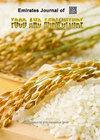通过寡磷酸酵母发酵提高木薯皮-叶混合物(CPLM)作为家禽饲料的质量
IF 0.7
4区 农林科学
Q3 AGRONOMY
引用次数: 0
摘要
木薯(Manihot utilissima)是印度尼西亚潜在的粮食商品之一。印度尼西亚的木薯产量相对较高。当然,它也会产生许多废物,如木薯皮(CP)和木薯叶(CL)。木薯皮和木薯叶具有用作饲料原料的潜力,但由于质量不高,只能在家禽饲料中使用 10%。因此,有必要研究如何通过低聚木糖酵母发酵提高木薯皮-叶混合物(CPLM)的质量,并将其作为家禽饲料。本实验采用完全随机设计(CRD),四个处理五个重复。处理为木薯皮-叶混合物(CPLM)经低磷酵母发酵。处理为 A(9:1)、B(8:2)、C(7:3)和 D(6:4)。观察变量包括粗纤维消化率(DCF)、蛋白酶活性、粗蛋白(CP)、氮保留率(RN)、代谢能(ME)和粗纤维(CF)。多样性分析表明,多样性对 CPLM 发酵的(DCF)、粗蛋白(CP)、蛋白酶活性、粗纤维(CF)、氮保留(RN)和能量代谢(ME)有非常显著的影响(P<0.01)。根据研究结果,可以得出结论:用寡甘磷发酵的 CPLM(6:4)效果最好。关键词寡osphorus;木薯皮;木薯叶;发酵;家禽本文章由计算机程序翻译,如有差异,请以英文原文为准。
Improving the quality of Cassava Peel-Leaf Mixture (CPLM) through fermentation with R. oligosphorus as poultry ration
Cassava (Manihot utilissima) is one of the potential food commodities in Indonesia. Cassava production in Indonesia is relatively high. Ofcourse, it will produce much waste, such as Cassava Peel (CP) and Cassava Leaf (CL). Casava peel and casava leave has the potential to be used as feed ingredients but is constrained by low quality, and they can only be used 10% in poultry rations. For that, it is necessary to research to improve the quality of Cassava Peel-Leaf Mixture (CPLM) through fermentation with R.oligosphorus as a poultry ration. This experimental study uses a completely randomized design (CRD) with four treatments and five replications. The treatments were cassava peel-leaf mixture (CPLM) fermented with R. oligosphorus. The Treatments were A (9:1), B (8:2), C (7:3), and D (6:4). The variables observed were the digestibility of crude fiber (DCF), the activity of protease enzymes, crude protein (CP) nitrogen retention (RN), metabolic energy (ME), and crude fiber (CF). The diversity analysis showed a very significant effect (P<0.01) on (DCF), crude protein (CP), protease activity, crude fiber (CF), nitrogen retention (RN), and energy metabolism (ME) of CPLM fermentation. Based on the study’s results, it can be concluded that CPLM (6:4) fermented with R.oligosphorus gave the best results. Keywords: R. oligosphorus; Casava peel; Casava leave; Fermented; Poultry
求助全文
通过发布文献求助,成功后即可免费获取论文全文。
去求助
来源期刊

Emirates Journal of Food and Agriculture
AGRONOMYFOOD SCIENCE & TECHNOLOGY&nb-FOOD SCIENCE & TECHNOLOGY
CiteScore
1.80
自引率
0.00%
发文量
18
期刊介绍:
The "Emirates Journal of Food and Agriculture [EJFA]" is a unique, peer-reviewed Journal of Food and Agriculture publishing basic and applied research articles in the field of agricultural and food sciences by the College of Food and Agriculture, United Arab Emirates University, United Arab Emirates.
 求助内容:
求助内容: 应助结果提醒方式:
应助结果提醒方式:


